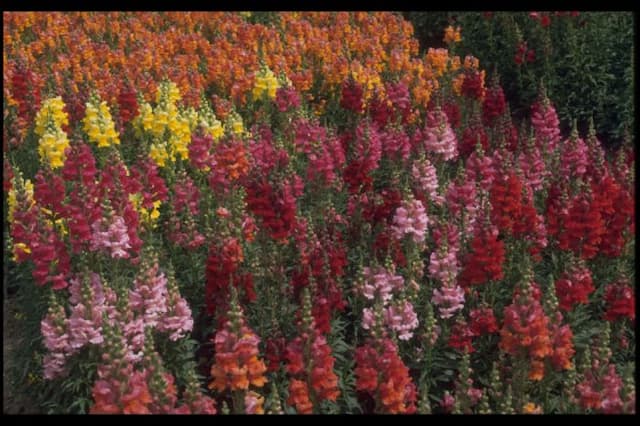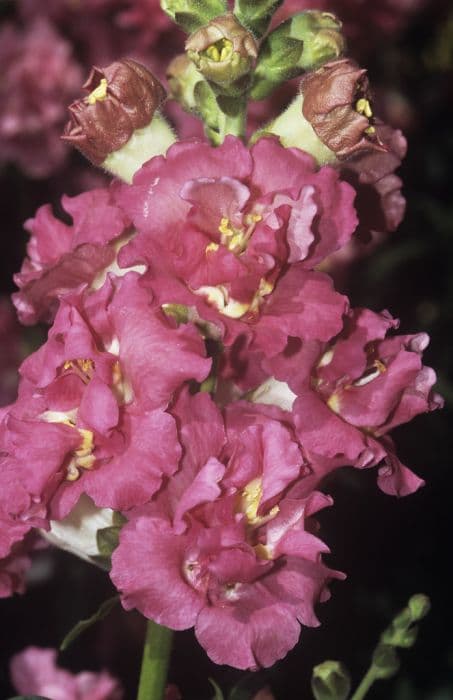Penstemon 'Blueberry Fudge' Penstemon 'Blueberry Fudge' (Ice Cream Series)

ABOUT
A selection with lavender-purple flowers and clear, white throats. Height to around 60cm
About this plant
 Names
NamesFamily
Plantaginaceae
Synonyms
Beard Tongue, Beardtongue
Common names
Penstemon 'Blueberry Fudge' (Ice Cream Series).
 Characteristics
CharacteristicsLife cycle
Perennials
Foliage type
Deciduous
Color of leaves
Green
Flower color
Purple
Height
1-2 feet (30-60 cm)
Spread
1-2 feet (30-60 cm)
Plant type
Herb
Hardiness zones
7
Native area
North America
Benefits
 General Benefits
General Benefits- Attractive Blooms: Penstemon 'Blueberry Fudge' produces richly colored, tubular flowers that can add visual appeal to gardens and landscapes.
- Pollinator Friendly: The flowers attract bees, butterflies, and hummingbirds, making it an asset for pollinator gardens.
- Long Flowering Period: This cultivar has an extended blooming season, often from late spring to early fall, providing a long-lasting display of color.
- Drought Tolerant: Once established, Penstemon 'Blueberry Fudge' can tolerate periods of dryness, making it suitable for xeriscaping or water-wise gardens.
- Low Maintenance: It does not require much care beyond the occasional pruning and deadheading to promote more blooms and maintain its shape.
- Versatility: This plant can be used in a variety of garden settings, including borders, rock gardens, and containers.
- Cold Hardy: It is capable of withstanding cooler temperatures, which makes it a good choice for gardeners in temperate climates.
 Medical Properties
Medical PropertiesThis plant is not used for medical purposes.
 Air-purifying Qualities
Air-purifying QualitiesThis plant is not specifically known for air purifying qualities.
 Other Uses
Other Uses- Garden Photography: Penstemon 'Blueberry Fudge' adds a unique color palette to garden photography projects, particularly valuable for those looking to capture vibrant and unusual flower hues.
- Floral Art: The striking deep purple flowers can be used in floral art, such as creating pressed flower decorations or inclusion in mixed media art pieces.
- Ink Dye: Petals from Penstemon 'Blueberry Fudge' could potentially be used to create natural dyes for inks, offering a distinctive purplish tint.
- Educational Tool: This plant species can serve as an educational tool in botany classes to discuss flower structure, pollination, and plant breeding.
- Theme Gardens: It can be incorporated into theme gardens such as 'chocolate' or 'dessert' themed plots due to its evocative name and rich color.
- Crafting Petal Confetti: Dried petals of Penstemon 'Blueberry Fudge' can be used as biodegradable confetti for eco-friendly celebrations.
- Color Theme Landscaping: Its unique coloration makes it a prime candidate for color-themed landscaping designs, such as a purple and white color-schemed garden.
- Plant Collecting: Due to its distinctive appearance, Penstemon 'Blueberry Fudge' is ideal for plant collectors looking to add special cultivars to their collections.
- Culinary Presentation: Although not edible, the flowers can be used as a non-toxic garnish for desserts and other dishes to enhance their visual appeal.
- Mood Boards: The striking petals can be used to create mood boards for designers seeking inspiration for color schemes and textures.
Interesting Facts
 Feng Shui
Feng ShuiThe Penstemon is not used in Feng Shui practice.
 Zodiac Sign Compitability
Zodiac Sign CompitabilityThe Penstemon is not used in astrology practice.
 Plant Symbolism
Plant Symbolism- Attraction: The vibrant colors of the Penstemon, particularly the 'Blueberry Fudge', are often seen as a symbol of attraction and captivating beauty, drawing in both people and pollinators alike.
- Versatility: Penstemons, with their variety of colors and adaptability, are seen as a symbol of versatility, able to thrive in diverse conditions and environments.
- Determination: As a plant that can grow in rocky, challenging conditions, the Penstemon represents determination and the ability to persist through tough situations.
- Health: In some cultures, certain species of Penstemon are used medicinally, which can make them a symbol of health and healing.
- Love: Given its lush and rich coloration, the 'Blueberry Fudge' can symbolize deep affection and the richness of love, drawing parallels to the indulgence and pleasure associated with its 'Ice Cream Series' nomenclature.
 Water
WaterBeardtongue prefers consistent moisture, especially during the growing season. Water thoroughly, allowing the soil to become dry to the touch between watering cycles, which generally means about once a week. Depending on weather conditions, this may translate to about 1 inch of water each week. In hot, dry periods, you may need to increase watering frequency but always check the soil moisture level first. Overwatering can be detrimental, leading to root rot, so it's crucial to ensure proper drainage and not let the plant sit in water.
 Light
LightBeardtongue thrives in full sun to partial shade. The ideal location is a spot that receives at least 6 to 8 hours of direct sunlight daily. If grown indoors, a bright south-facing window can be an excellent spot. In regions with very hot summers, afternoon shade can help prevent scorching of the leaves.
 Temperature
TemperatureBeardtongue is hardy in temperatures ranging from approximately 20°F to 90°F but prefers a moderate climate. The ideal temperature range for robust growth is between 60°F and 75°F. Extremes below 20°F or above 90°F can stress the plant and may require protective measures such as mulching or shade covers.
 Pruning
PruningPruning Beardtongue encourages bushier growth and more blooms. Prune in the early spring to remove any dead or damaged stems, and deadhead spent flowers to promote continuous blooming throughout the season. Cutting back the plant by about one-third after the first bloom can stimulate a second bloom period later in the summer.
 Cleaning
CleaningAs needed
 Soil
SoilBeardtongue prefers well-draining soil with a slightly acidic to neutral pH between 6.0 and 7.0. A mix of loam, sand, and a small amount of compost is ideal. Ensure good drainage to prevent root rot, and amend with organic material to encourage healthy growth.
 Repotting
RepottingBeardtongue typically needs repotting every 2-3 years or when it becomes root-bound. The best time to repot is in spring before new growth begins, using a fresh soil mix that matches the plant's requirements outlined above.
 Humidity & Misting
Humidity & MistingBeardtongue does best in moderate to low humidity conditions as it's adapted to somewhat dry climates. Aim for humidity levels between 40% to 50%, typical of many indoor environments, to keep the plant healthy.
 Suitable locations
Suitable locationsIndoor
Place Beardtongue in bright, indirect light and ensure good air flow.
Outdoor
Plant Beardtongue in full sun to partial shade and well-draining soil.
Hardiness zone
6-9 USDA
 Life cycle
Life cycleThe life cycle of Penstemon 'Blueberry Fudge' begins with seed germination in well-drained soil and under suitable temperature conditions, generally in late winter to early spring if outside but they can be planted indoors before the last frost. After germination, the seedlings grow and develop a root system and foliage, entering the vegetative stage. Following the vegetative stage, the plant enters the flowering phase during spring to summer, producing attractive bell-shaped blue to purple flowers that attract bees and butterflies. After flowering, the plant sets seed, and these seeds can be collected for propagation or allowed to fall to the ground where they may germinate to start a new plant life cycle. In autumn, the plant begins to enter dormancy, with foliage dying back as temperatures drop, especially in regions with cold winters, although in some warmer climates, the plant may remain semi-evergreen. If the plant survives winter, it will resume growth from the root system in the following spring, continuing its perennial cycle.
 Propogation
PropogationPropogation time
Spring-Early Summer
The Penstemon 'Blueberry Fudge', commonly referred to as Beardtongue, can be propagated most effectively by softwood cuttings. This technique is usually carried out in late spring or early summer when new growth is just beginning to harden off. To propagate by cuttings, gardeners should select a healthy, non-flowering stem and make a cut just below a leaf node using a sharp, clean instrument. The cutting should be about 2-4 inches (5-10 centimeters) long, and the lower leaves should be removed. Dipping the cut end into a rooting hormone can enhance the chances of successful rooting. The cutting is then planted in a moist, well-draining soil mix, making sure a few leaf nodes are below the soil surface. It's important to keep the soil consistently moist and to provide a warm environment with indirect sunlight until roots develop, which may take several weeks.





![Snapdragon [Pretty in Pink]](/_next/image?url=https%3A%2F%2Fplants-admin.emdemapps.com%2Fimages%2Fplants%2F%2Fimages%2F604b5cb3b5385.png&w=640&q=75)



